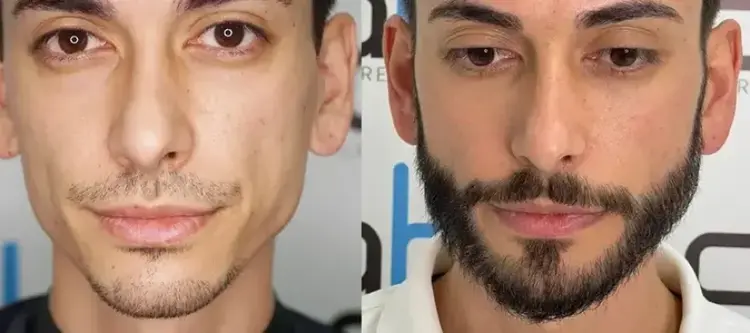Our article is a comprehensive resource containing answers to all the frequently asked questions about beard transplantation. We hope that by the end of this article, anyone considering a beard transplant will have gained extensive knowledge on the subject.
A beard is the general term for the hair that grows on a man’s cheeks, chin, and neck. In terms of makeup and aesthetics, a beard is an essential element of appearance for many men.
Beard typically begin to grow during puberty under the influence of the testosterone hormone in men and reach its ideal density by the age of 20. However, in some cases, a beard may not grow at all, or it may grow sparsely, unevenly, or in a non-uniform pattern.
The non-uniform gaps in the beard create aesthetic concerns for many people, leading them to seek various solutions to address this issue. This is because men generally perceive the beard as a sign that completes masculinity and self-confidence.
In cases of beard deficiency or absence, surgical or other medical interventions may come to mind as possible solutions. Now, we are going to take a detailed look at these treatment options.
What Is Beard Transplantation?
Beard transplantation refers to the transfer of healthy hair follicles to areas on the throat, chin, and cheeks where there is no beard growth or sparse hair due to genetic or other reasons. The fundamental rule in this procedure is that the transplanted follicles must be the individual’s own strong hair follicles.
The problems mentioned above can also occur in the mustache area. For this reason, beard and mustache transplantation is generally performed together.

In Turkey, you can find many doctors and clinics that successfully perform beard transplantation surgery.
Who Is Eligible for Beard Transplantation?
Can everyone get a beard transplant, and is everyone suitable for this procedure? The answer to this question would be, of course, no. However, it should be noted that individuals who are suitable candidates for beard transplantation can achieve highly satisfactory and permanent results from this treatment. So, who can expect a successful outcome from this procedure? Let’s explore the answer to this question.
Before deciding on the operation, it is essential to consider the following two criteria:
- The size of the transplantation area and the number of follicles to be implanted is the most crucial factor that directly affects the outcome. The number of follicles placed per square centimeter plays a significant role in achieving the desired aesthetic appearance in beard transplantation.
2.The thicker the grafts, the denser the transplanted beard will appear.
We can categorize individuals who may undergo beard transplantation into five groups:
1) Beard Transplantation for Individuals with No Facial Hair
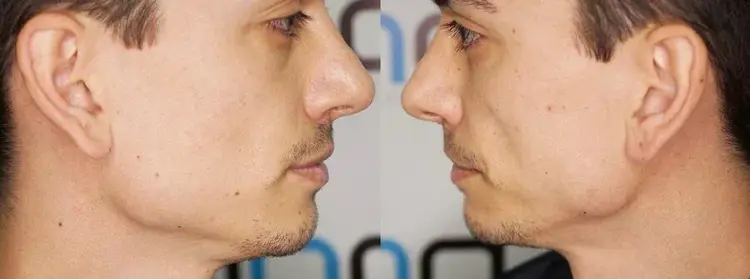
Due to hormonal reasons, men who do not grow any facial hair or have very sparse growth in the mustache, cheek, and chin areas are called beardless. For these individuals, medical treatment should be the first option. If no response is obtained from medical treatment by the age of 25, it would be more appropriate to proceed with a beard transplant. And. this treatment yields highly successful results.
2) Beard Transplantation for Those with Sparse Beard or Mustache
Some men may have patchy beard growth with areas where facial hair does not grow on the cheeks, face, or chin. For these individuals, beard densification can be performed to address the issue. The majority of people applying for a beard transplant belong to this group.
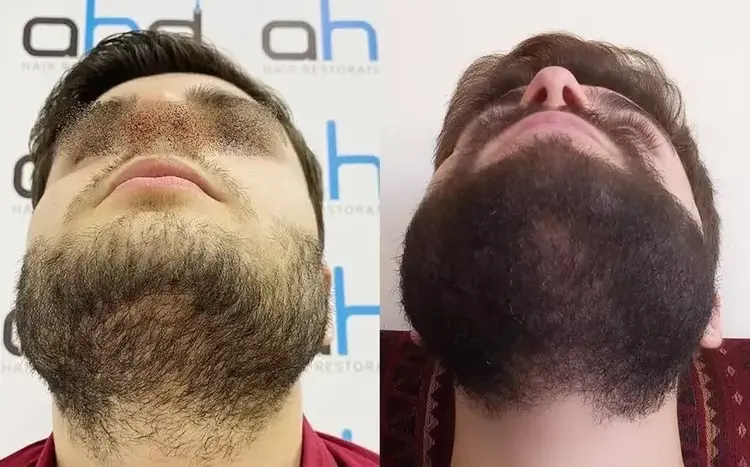
3- Beard Transplantation for Scar and Burn Marks
There may be damaged areas on the facial region where tissue integrity has been disrupted due to previous traffic accidents, burns, or surgeries. Such conditions can significantly impact a person’s psychological well-being. Beard transplantation can provide excellent and highly satisfying results for these individuals.
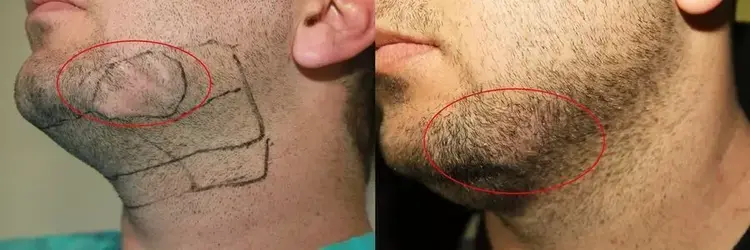
Below, you can see the before-and-after images of a beard transplant performed on a person who suffered facial burns during childhood.
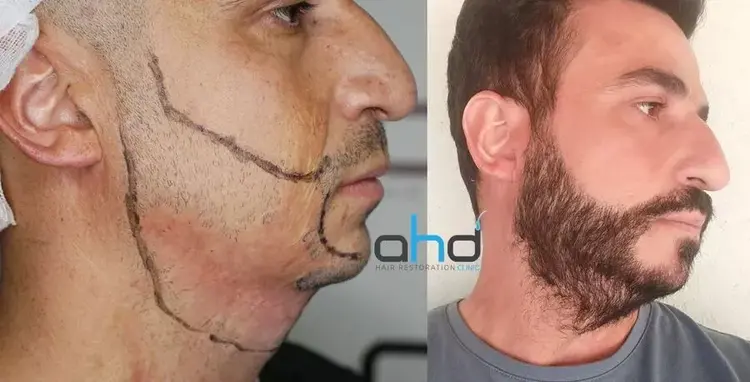
4- Correction of a Poorly Performed or Failed Beard Transplant
Beard transplantation operation has its own specific set of rules. If the procedure is performed carelessly, without adhering to these principles, unnatural-looking results may occur. In such cases, correction procedures are difficult but possible.
5- Beard Transplantation for Transgender Individuals
Individuals transitioning from female to male may wish to undergo a beard transplant.
How is beard transplantation performed?
In fact, the process of beard transplantation is not different than hair transplantation. The main goal is to fill in the sparse areas of the beard region. Let’s break down the process of beard transplantation step by step:
- Initial Examination and Evaluation: First, the patient is examined by an experienced doctor. Both the donor area and the recipient area are assessed. After this evaluation, the required number of grafts is calculated. If necessary, blood tests may be conducted. If the person is found suitable for the procedure, the area for transplantation is marked using a drawing pencil.
- Harvesting the Grafts: The required number of grafts is carefully extracted from the donor area under local anesthesia using the FUE technique one by one.
- Transplantation to the Beard Area: After the grafts are harvested, they are carefully implanted one by one into the planned beard area following local anesthesia.
This can be done using one of the following three methods:
a) DHI Beard Transplantation: This method tends to produce the best and most natural results.
b) FUE Channel Method
c) Stick and Place Needle Technique
What Are the Donor Areas Used for Beard Transplantation?
In beard transplantation, donor areas are typically the beard and hair follicles. Here’s a breakdown:
1.Hair to Beard Transplantation: If a high number of grafts is required, meaning a large area will be transplanted, it is more logical to use the hair follicles from the back of the head. For example, beardless individuals may require a significant number of grafts. Therefore, the grafts are taken from the donor area at the back of the neck.
2. Beard to Beard Transplantation: If the area to be transplanted is small and the number of grafts is low, it is more effective to transplant from the stronger and denser beard hair to the sparse or empty areas.
DHI Beard Transplantation
This method, also known as the implanter pen technique, has a higher success rate for beard transplantation. For this reason, AHD Clinic has been performing a variety of procedures, including hair, beard, mustache, and eyebrow transplants, exclusively using the DHI technique since 2010.
The DHI technique offers many advantages, such as fast recovery, a natural appearance, and the ability to perform more frequent transplants.
How Many Grafts Are Needed?
The number of grafts required for a beard transplant will vary depending on the size of the area to be transplanted. To explain the number of grafts with examples:
| Transplant Type | Number of Grafts | Explanation |
| Beard Transplant for beardless individual | 4000-5000 | There must be a sufficient number of donor. This procedure is usually completed in 2 days. A follow-up transplant may be needed after 1 year. |
| Beard Thickening | 500-2000 | The number will vary depending on the size of the area to be transplanted. |
| Cheek and Jaw Area | 750-1000 | For each cheek and facial area. |
| Sideburn Area | 200-300 | For each sideburn area |
| Scar or Burn Mark Transplant | 150-1000 | The number of grafts will vary depending on the size of the scarred area. These are estimated figures. |
How to Achieve a Natural Appearance in Beard Transplant?
Do not forget this. An unnatural beard appearance will definitely make you unhappy. In order to achieve a natural appearance, beard transplantation must be performed by following certain rules. We can summarize these rules in 3 points
- The grafts to be used in the transplant should consist of single follicles. Especially in the outer lines where the beard ends, multiple follicles should definitely not be used. It would be better to separate the multiple grafts taken from the nape into single follicles before transplantation.
- The holes to be created should be very thin and evenly distributed: If the holes created are large, pits may be visible at the base of the transplanted follicles. With 0.6 and 0.8 mm implanter pen tips, the possibility of scarring is almost nonexistent.
- For a natural appearance, the channels must be opened at the correct angle and in the correct direction. For example, in the face area, channels should be opened at angles of 5-10 degrees, with the direction pointing downward. In the image below, you can see the correct direction in which the channels should be opened.
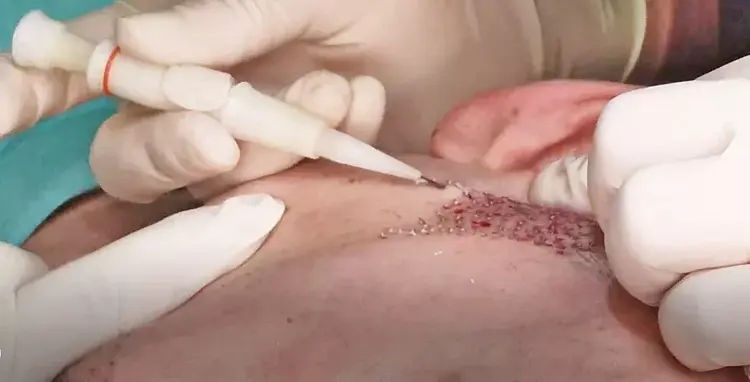
If the above 3 rules are not followed, a natural appearance will definitely not occur, and a failed result will emerge. Upright multiple grafts and pits at the base of the transplanted roots are unfortunately the result of such faulty transplants. This happens because a beard transplant was performed without adhering to the 3 above-mentioned rules. Keep in mind that the regret rate for beard transplants due to faulty and unsuccessful results is quite high.
Beard Transplantation Prices in Turkey
For those considering a beard transplant, determining the budget for the procedure is undoubtedly important. There are 4 main factors that influence beard transplantation prices both worldwide and in Turkey. Let’s briefly examine these criteria:
- Number of Grafts: The size of the area to be transplanted and the number of grafts required are the primary factors determining the price. This is because many doctors charge based on the number of grafts. However, some clinics set a fixed price regardless of the graft count.
- Brand Value of the Doctor and Clinic: It is clear that a three-star hotel and a five-star hotel do not have the same price. Just like that, the cost of a procedure performed by a well-known and reputable doctor will not be the same as one done at a lesser-known clinic.
- The Technique Used: In general, mustache and beard transplants performed using the implanter pen technique tend to be more expensive. This is because the materials used in this method are quite expensive. Additionally, this technique requires more knowledge and experience, and there are fewer doctors skilled in it. However, in terms of results, it is a more effective technique. On the other hand, the FUE (Follicular Unit Extraction) beard transplantation method is relatively more affordable.
- Additional Costs: Accommodation, transfers, and post-procedure medical kits will also affect the overall cost. Some clinics provide pricing that includes these services in their package offers.
How Much Does a Beard Transplant Cost in Turkey and Around the World?
Another factor that determines the cost of a beard transplant is geographical location. This is because expenses such as rent, taxes, and labor costs vary not only from country to country but even from city to city.
Considering these factors, it is evident that prices in Turkey are significantly more affordable compared to Europe and the USA. In fact, the primary reason for the high demand for hair and beard transplants in Turkey is the reasonable pricing.
When looking at different countries, the cost range can be summarized as follows:
| Country | Price Range |
| Turkey | Prices range between 50,000 – 250,000 TL is possible. That is approximately 1,700 – 8,000 EUR/USD. |
| Europe | The cost per graft varies between 4 – 8 EURO. The total costs are ranging from 5,000 – 15,000 EURO. |
| USA | The cost per graft is around 4 – 10 USD, and the total expense can range between 5,000 – 20,000 USD. |
Factors to Consider When Researching Beard Transplant Prices
When making research on beard transplantation, price alone should not be the only determining factor. While comparing costs, you should also consider the following crucial aspects:
- Does the clinic you researched inspire confidence?
- Are you sure that the clinic will support you in case of complications or adverse effects?
- Review comments, recommendations, and complaints about clinics on forum pages.
- Find out how many years of experience the doctor you are considering for your transplant has. Be sure to research the clinic and doctor you choose.
- Compare before and after photos of doctors who have performed beard transplants. This will help you find the best option for you.
- The most expensive or cheapest clinic may not be the best option. Keep this in mind when researching prices.
- Don’t let advertisements be the sole factor in your decision. Unfortunately, misleading advertisements are quite common.
Remember that beard transplantation is a procedure that requires special artistic design. The cost of correcting an unsuccessful transplantation can be much higher. To be honest, if you decide to undergo beard transplantation without doing sufficient research, you are more likely to regret the results.
If you follow our advice, you will increase your chances of achieving the happy ending you desire.
Contact with AHD Clinic
FREQUENTLY ASKED QUESTIONS
How long does a beard transplant take?
The duration of the operation depends on the size of the area to be transplanted and the number of grafts required. For example:
● A transplant of 4000-5000 grafts for a beardless individual can take –>2-3 days.
● As a general rule, it is better to split numbers above 2000 grafts into 2 days.
● A transplant of 1000 grafts typically takes about 4-5 hours.
Do the transplanted beards fall out?
In beard transplantation, it is important to take the strongest follicles from the donor area. This ensures that the transplanted beards grow healthy and last for a long time in the transplanted area. In other words, the transplanted beards do not fall out later and remain at the desired length.
Is beard transplantation painful?
It would not be accurate to say that this procedure is completely painless. There will be some pain during the local anesthesia stage for about 3-5 minutes. The level of pain experienced during anesthesia varies from person to person. However, after the anesthesia process, there will be no pain or discomfort.
At what age can beard transplantation be done?
● Actually, there is no definite age limit. It is correct to wait until the age of 25 for beardless individuals. If there is no response to medical treatment by this age, beard transplantation can be done.
● The ideal age for thickening sparse beards is 20.
● Beard transplantation can be done at any age on scar areas, such as burn surgery scars.
Is beard transplantation safe?
As long as anesthesia and operational procedures are followed, beard transplantation is not a procedure to be worried about. If you want to achieve natural and successful results, you should choose proven and experienced doctors
If you are considering beard transplantation, you can contact AHD Clinic through our WhatsApp line. If you are suitable for the operation, it is possible to achieve a natural result with us. Necessary information will be provided to you.

